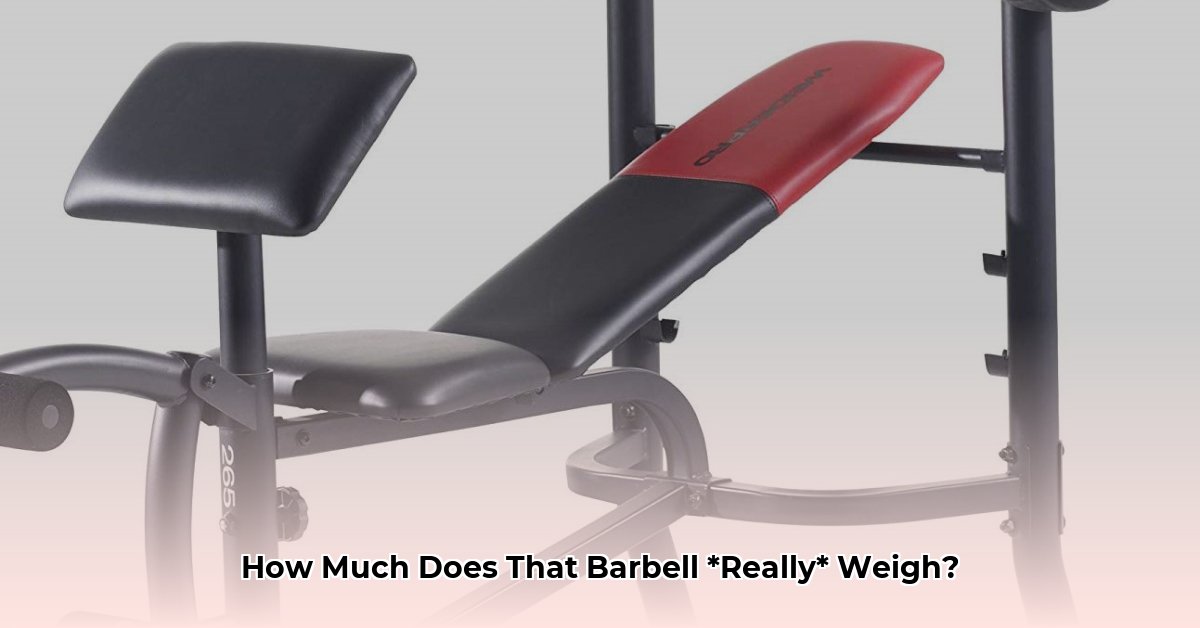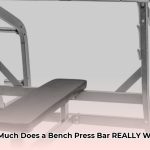Knowing your barbell’s weight is crucial for calculating your total lift, choosing appropriate weights, and tracking your progress. This guide breaks down the weights of different barbells, their uses, and how to choose the right one for you.
Barbell Weight Basics
Before diving into specifics, let’s establish the foundation: the standard barbell weight. Most likely, the barbell you’ll encounter in a gym weighs 45 pounds. This is the standard men’s Olympic barbell, a staple in weightlifting and powerlifting. However, barbells come in various weights and sizes, each designed for specific purposes.
Barbell Types and Weights
This section provides a quick reference for different barbell types. Remember, these are typical weights; always check the manufacturer’s specifications, especially for specialty bars.
| Barbell Type | Weight (lbs) | Weight (kg) | Length (ft) | Diameter (inches) | Key Features | Image |
|---|---|---|---|---|---|---|
| Men’s Olympic Barbell | ~45 | ~20.4 | ~7 | ~1.1 | Rotating sleeves, moderate “whip” for dynamic lifts, knurled grip. | |
| Women’s Olympic Barbell | ~35 | ~15.9 | ~6 | ~0.97 | Rotating sleeves, thinner grip, lighter weight. | |
| Powerlifting Barbell | ~45 | ~20.4 | ~7 | ~1.1 – ~1.26 | Stiffer than Olympic bars for maximal stability, aggressive knurling. | |
| Training Barbell | ~15 – ~35 | ~7 – ~16 | Variable | Variable | Lighter and shorter for technique practice and beginners. | |
| Safety Squat Bar (SSB) | ~65-75 | ~29.5-34 | Variable | Variable | Padded yoke for shoulders, curved design. | |
| Trap Bar (Hex Bar) | ~45-65 | ~20.4-29.5 | Variable | N/A | Hexagonal shape, allows lifter to stand inside, various grip options. | |
| Swiss Bar | ~35-55 | ~15.9-25 | Variable | Variable | Multiple neutral grips, can reduce wrist strain. |
(Note: Replace the image placeholders with actual images.)
Understanding Each Barbell Type
Men’s Olympic Barbell: The Versatile Choice
This is the most common barbell, suitable for a wide range of exercises, from squats and bench presses to Olympic lifts. Its moderate “whip” (flexibility) is advantageous for dynamic movements, while the knurling ensures a secure grip.
Women’s Olympic Barbell: Enhanced Comfort
Designed with a thinner grip diameter and lighter weight, this bar is often preferred by lifters with smaller hands or those new to weight training. While commonly used by women, it’s suitable for any lifter who finds it more comfortable.
Powerlifting Barbell: Built for Strength
With its increased stiffness and aggressive knurling, the powerlifting barbell provides superior stability for heavy lifts. This rigidity minimizes bar bend, which is crucial for maximizing strength in exercises like squats and deadlifts.
Training Barbell: Mastering the Fundamentals
Ideal for beginners, training barbells are lighter and shorter, allowing for focused technique practice without the added weight. They provide a safe and effective way to learn proper form before progressing to heavier barbells.
Specialty Bars: Targeting Specific Goals
Specialty bars, like the trap bar and Swiss bar, offer unique benefits and variations for specific training goals. The trap bar, for example, allows for a more upright torso during deadlifts, potentially reducing strain on the lower back. The Swiss bar facilitates neutral-grip exercises, which can be easier on the wrists and elbows. Some research suggests that specialty bars can enhance muscle activation in specific areas compared to traditional barbells, but more studies are needed to understand these effects fully. Ongoing research explores the biomechanics of these unique bar designs and their impact on muscle recruitment.
Choosing Your Barbell: A Personalized Approach
Selecting the right barbell depends on several factors, including your training goals, experience level, and hand size.
- Beginners: Start with a training barbell or a women’s Olympic barbell. A study published in the Journal of Strength and Conditioning Research suggests that starting with a lighter bar can improve long-term technique.
- Experienced Lifters: The standard Olympic barbell is a versatile choice for various training styles.
- Powerlifters: A powerlifting barbell is essential for maximizing strength and stability in heavy lifts.
- Specific Needs: Consider specialty bars for addressing particular training goals or working around injuries.
Barbell Maintenance and Safety
Proper barbell maintenance is crucial for safety and longevity. Regular cleaning and lubrication of the sleeves (rotating parts) will keep your barbell in top condition.
- Cleaning: Wipe down the bar after each use with a gym wipe or a damp cloth with mild soap (followed by thorough drying). Use a barbell brush to remove chalk or other buildup in the knurling.
- Lubrication: Apply barbell-specific lubricant to the sleeves regularly to ensure smooth rotation. Avoid using WD-40 or other household oils, as they can damage the bearings.
And finally, remember that proper lifting technique is paramount, regardless of which barbell you choose. Always prioritize form to avoid injuries. If you’re unsure about proper technique, consult with a qualified fitness professional. Consulting resources like Starting Strength by Mark Rippetoe or articles on Breaking Muscle can also provide valuable insights.
FAQs
Q: Why is the standard bar 45 pounds?
A: The 45-pound weight is a standard adopted by the International Weightlifting Federation (IWF), making it universally recognized for competitions. While the origins of this specific weight are debated, its standardization ensures consistency across weightlifting and related disciplines.
Q: What’s the difference between an Olympic bar and a powerlifting bar?
A: The main differences are stiffness and knurling. Powerlifting bars are stiffer to provide more stability for maximal lifts, while Olympic bars have some “whip” for dynamic movements. Powerlifting bars often feature more aggressive knurling.
Q: How do I choose the right barbell for bench pressing?
A: For beginners, the standard or women’s Olympic bar is a good starting point. Powerlifters benefit from a dedicated powerlifting bar’s stability. The choice depends on your experience level and training goals.
Conclusion
Choosing the right barbell can significantly impact your training. This guide provides a comprehensive overview to help you make informed decisions. Remember to always prioritize safety and proper form, and don’t hesitate to seek expert advice when needed.
- Wellness Fair Ideas for Work to Boost Employee Wellbeing - December 15, 2025
- Affordable Employee Wellness Fair Ideas for Any Budget - December 14, 2025
- Employee Wellness Programs Strategically Benefit Employee Health And Retention - December 13, 2025
















